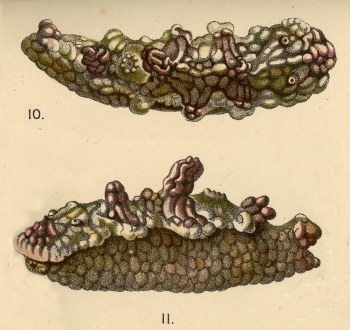
Ceratosoma magnificum
(Eliot, 1910)
Order: NUDIBRANCHIA
Suborder: DORIDINA
Superfamily: EUDORIDOIDEA
Family: Chromodorididae
DISTRIBUTION
Western Indian Ocean?
PHOTO
Miamira magnifica: original illustrations from Eliot, 1910: Pl. 25.
Note added 4 July 2007: The name is changed today from C. magnifica to C. magnificum - see message #20101.
Until now I have, like Baba & Hamatani (1974), considered all the various coloured forms of 'Miamira' to be part of one variable species of Ceratosoma, C. sinuatum [see message #19853] but the persistent use of the name 'Miamira magnifica' and 'Ceratosoma magnifica' in colour picture books has caused widespread confusion.
While it has been possible to identify C. sinuatum and C. flavicostatum from their original descriptions, the original description of C. magnificum is so lacking in detail of the living animal that it is very difficult to be sure just what the name represents [see message #19854 ].
Like so many early descriptions, it was based on a single preserved specimen from the Seychelles, and as Eliot notes 'this description was taken from the preserved animal some time after the colour drawing was made'. In this description he mentions greens and purples and white spots, but we have no idea whether these colours represent the live animal or are the result of the pigments reacting to preservatives. If the greens are real colours then C. magnificum might be the same as C. sinuatum because C. flavicostatum does not have green coloration, but from the original drawings we can see that the mantle has a pattern of rounded tubercles and some short ridges. Eliot does note that the oral tube is a 'beautiful purple colour' and the rachis of the gills is a yellowish white, making 'a vivid contrast of colours' which may suggest C. flavicostatum, but we can't be sure.
Is is possible that Eliot's M. magnificum is a third species. At present we have no record of a living 'flavicostatum'- like animal from the western Indian Ocean, where M. magnificum was found. However there are three records on the Forum of 'sinuatum'-like animals with yellow lines on the rhinophore clubs, one from South Africa [#2147] with white edged gills and two from the Red Sea [#13210, #6822], with red edged gills. Perhaps this is Eliot's species? At present I am recognising C. sinuatum and C. flavicostatum, because they are identifiable, and tentatively recognising C. magnificum for the few anomolous western Indian Ocean animals I mention above.
-
Baba, K. (1940) Miamira flavicostata n.sp., a nudibranchiate mollusc from Amakusa, Japan. Zoological Magazine, Japan 52(6), 239-240.
-
Baba, K & Hamatani, I. (1974) On the synonymy of Miamira sinuata (van Hasselt, 1824) from Japan (Nudibranchia: Dorididae: Miamirinae). Venus, The Japanese Journal of Malacology 33 (2, August), 81-84.
-
Eliot, C.N.E. (1910) Nudibranchs collected by Mr. Stanley Gardiner from the Indian Ocean in H.M.S. Sealark. Reports of the Percy Salden Trust Expedition to the Indian Ocean in 1905, under the leadership of Mr. J. Stanley Gardiner, M.A. Transactions of the Linnean Society, Zoology, series 2, 13(2), 411-439, Pl. 25.
-
Valdes, A. & Gosliner, T. (1999) Reassessment of the systematic status of Miamira Bergh, 1875 and Orodoris Bergh, 1875 (Nudibranchia; Chromodorididae) in light of phylogenetic analysis. Journal of Molluscan Studies, 65:33-45.
Rudman, W.B., 2007 (April 30) Ceratosoma magnificum (Eliot, 1910). [In] Sea Slug Forum. Australian Museum, Sydney. Available from http://www.seaslugforum.net/factsheet/ceramagn
Related messages
-
Ceratosoma sinuata or what?
From: Erwin Koehler, June 19, 2007 -
Re: Is Ceratosoma magnifica a good species ?
From: Erwin Koehler, June 19, 2007 -
Mantle glands in Ceratosoma magnifica? from the Red Sea
From: Bill Rudman, May 8, 2007 -
Re: Ceratosoma magnifica? from the Red Sea
From: Binyamin Koretz, May 7, 2007 -
Ceratosoma magnifica? from the Red Sea
From: Oren Lederman, April 30, 2007 -
Is Ceratosoma magnifica (Eliot, 1910) a good species?
From: Bill Rudman, April 30, 2007 -
Ceratosoma sinuata from the Red Sea
From: Dr. Jacob Dafni, May 6, 2002 -
Miamira magnifica? from South Africa
From: Valda Fraser, March 27, 2000
